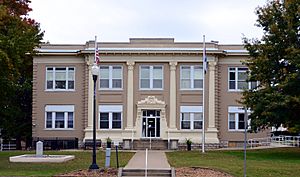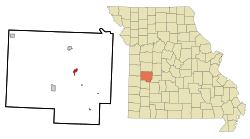Osceola, Missouri facts for kids
Quick facts for kids
Osceola, Missouri
|
|
|---|---|

St. Clair County Courthouse in Osceola
|
|

Location of Osceola, Missouri
|
|
| Country | United States |
| State | Missouri |
| County | St. Clair |
| Area | |
| • Total | 1.04 sq mi (2.70 km2) |
| • Land | 1.02 sq mi (2.63 km2) |
| • Water | 0.03 sq mi (0.06 km2) |
| Elevation | 748 ft (228 m) |
| Population
(2020)
|
|
| • Total | 909 |
| • Density | 893.81/sq mi (345.00/km2) |
| Time zone | UTC-6 (Central (CST)) |
| • Summer (DST) | UTC-5 (CDT) |
| ZIP code |
64776
|
| FIPS code | 29-55388 |
| GNIS feature ID | 2396092 |
Osceola is a city located in St. Clair County, Missouri, in the United States. It is also the county seat, which means it's where the county government is located. In 2020, about 909 people lived there. Osceola has an important place in history because of an event called the Sacking of Osceola during the American Civil War.
Contents
History of Osceola
Osceola is located along the Osage River. Long ago, the land was home to the Osage Native Americans. They were also known as NiuKonska, which means "Little Ones of the Middle Waters." The river got its name from them.
In the early 1800s, the Osage tribe signed two agreements with the U.S. government. These agreements, in 1808 and 1825, meant the tribe gave up all their land in Missouri. This opened the way for new settlers to move into the St. Clair County area in the mid-1830s.
The town of Osceola was named after a famous Seminole leader, Chief Osceola. The name was first used at a town meeting on March 30, 1859.
The Sacking of Osceola
A very important event in Osceola's history happened in September 1861. During the American Civil War, a group called Jayhawkers attacked the town. Jayhawkers were anti-slavery patrols. They burned most of the town and took valuable items from the courthouse.
Osceola had about 2,077 people at the time. The attackers freed 200 enslaved people. They also put nine local citizens on trial and executed them. This event was so dramatic that it inspired a movie. The 1976 Clint Eastwood film The Outlaw Josey Wales is based on these events.
In September 2011, Osceola marked 150 years since the Sacking. The town leaders asked the University of Kansas to stop using "Jayhawk" as their mascot. This was because the Jayhawks were the group that attacked Osceola.
Historic Buildings
The Osceola Public School Building is an important landmark. It was added to the National Register of Historic Places in 1999. This means it's recognized as a special place in history.
Geography and Climate
Osceola is a small city. According to the United States Census Bureau, it covers about 0.94 square miles (2.43 square kilometers). Most of this area is land, with a small part being water.
Local Climate
Osceola experiences a range of weather throughout the year. Here's a look at the typical climate:
| Climate data for Osceola, Missouri (1991–2020 normals, extremes 1955–present) | |||||||||||||
|---|---|---|---|---|---|---|---|---|---|---|---|---|---|
| Month | Jan | Feb | Mar | Apr | May | Jun | Jul | Aug | Sep | Oct | Nov | Dec | Year |
| Record high °F (°C) | 76 (24) |
83 (28) |
90 (32) |
97 (36) |
97 (36) |
104 (40) |
110 (43) |
110 (43) |
107 (42) |
96 (36) |
85 (29) |
76 (24) |
110 (43) |
| Mean daily maximum °F (°C) | 42.4 (5.8) |
47.3 (8.5) |
58.3 (14.6) |
67.5 (19.7) |
76.9 (24.9) |
85.5 (29.7) |
90.3 (32.4) |
89.3 (31.8) |
80.9 (27.2) |
69.8 (21.0) |
56.5 (13.6) |
45.7 (7.6) |
67.5 (19.7) |
| Daily mean °F (°C) | 31.7 (−0.2) |
35.9 (2.2) |
46.4 (8.0) |
56.0 (13.3) |
65.8 (18.8) |
74.8 (23.8) |
79.2 (26.2) |
77.8 (25.4) |
69.2 (20.7) |
57.8 (14.3) |
45.4 (7.4) |
35.4 (1.9) |
56.3 (13.5) |
| Mean daily minimum °F (°C) | 21.0 (−6.1) |
24.6 (−4.1) |
34.5 (1.4) |
44.4 (6.9) |
54.6 (12.6) |
64.0 (17.8) |
68.1 (20.1) |
66.2 (19.0) |
57.5 (14.2) |
45.7 (7.6) |
34.2 (1.2) |
25.0 (−3.9) |
45.0 (7.2) |
| Record low °F (°C) | −19 (−28) |
−20 (−29) |
−5 (−21) |
19 (−7) |
23 (−5) |
41 (5) |
44 (7) |
44 (7) |
29 (−2) |
20 (−7) |
0 (−18) |
−25 (−32) |
−25 (−32) |
| Average precipitation inches (mm) | 1.87 (47) |
2.09 (53) |
2.80 (71) |
4.62 (117) |
5.52 (140) |
5.12 (130) |
4.57 (116) |
3.82 (97) |
4.02 (102) |
3.49 (89) |
3.12 (79) |
2.20 (56) |
43.24 (1,098) |
| Average snowfall inches (cm) | 4.4 (11) |
1.5 (3.8) |
0.9 (2.3) |
0.0 (0.0) |
0.0 (0.0) |
0.0 (0.0) |
0.0 (0.0) |
0.0 (0.0) |
0.0 (0.0) |
0.0 (0.0) |
0.2 (0.51) |
3.1 (7.9) |
10.1 (26) |
| Average precipitation days (≥ 0.01 in) | 4.9 | 5.1 | 7.1 | 8.0 | 9.3 | 8.1 | 7.6 | 6.1 | 7.0 | 7.4 | 5.9 | 4.9 | 81.4 |
| Average snowy days (≥ 0.1 in) | 2.1 | 0.6 | 0.5 | 0.0 | 0.0 | 0.0 | 0.0 | 0.0 | 0.0 | 0.0 | 0.4 | 0.9 | 4.5 |
| Source: NOAA | |||||||||||||
Population and People
The number of people living in Osceola has changed over the years. Here's how the population has grown and shrunk:
| Historical population | |||
|---|---|---|---|
| Census | Pop. | %± | |
| 1860 | 314 | — | |
| 1870 | 331 | 5.4% | |
| 1880 | 373 | 12.7% | |
| 1890 | 995 | 166.8% | |
| 1900 | 1,037 | 4.2% | |
| 1910 | 1,114 | 7.4% | |
| 1920 | 1,025 | −8.0% | |
| 1930 | 1,043 | 1.8% | |
| 1940 | 1,190 | 14.1% | |
| 1950 | 1,082 | −9.1% | |
| 1960 | 1,066 | −1.5% | |
| 1970 | 874 | −18.0% | |
| 1980 | 841 | −3.8% | |
| 1990 | 755 | −10.2% | |
| 2000 | 835 | 10.6% | |
| 2010 | 947 | 13.4% | |
| 2020 | 909 | −4.0% | |
| U.S. Decennial Census | |||
2010 Census Information
In 2010, there were 947 people living in Osceola. These people lived in 394 households, and 225 of those were families. The city had about 1040 people per square mile.
Most of the people in Osceola were White (94.2%). There were also African American (1.7%), Native American (0.7%), and Asian (0.1%) residents. About 3.1% of the population identified as Hispanic or Latino.
About 31% of households had children under 18. Many households (39.6%) were individuals living alone. The average age in the city was 39.7 years old.
Education and Learning
The Osceola School District manages public education in the city. This includes local schools for students. Osceola also has a public library, which is called the Saint Clair County Library. It's a great place to find books and learn new things.
Fun Activities and Culture
The Osceola Chamber of Commerce helps organize many fun events. The biggest event each year is the Osceola Rodeo. This exciting event is part of Rodeo Daze.
Rodeo Daze happens every year on Labor Day weekend. It includes a street dance, food vendors, and a parade. The annual street dance is held on the Thursday before Labor Day.
Getting Around
If you need to travel to or from Osceola by bus, Jefferson Lines provides bus service to the city.
Famous People from Osceola
Some well-known people have connections to Osceola:
- Karolyn Grimes, a child actress
- Waldo Johnson, a United States Senator
- Thomas Marquis, a doctor and writer
- Tammy Williams, a softball player
- Warren Love, a Missouri representative
See also
 In Spanish: Osceola (Misuri) para niños
In Spanish: Osceola (Misuri) para niños

